Revision
Rhinoplasty
“What Is Revision Rhinoplasty?”
VIP’s revision rhinoplasty is a premium nose surgery to re-evaluate the nose shape and to alleviate previous functional problems. This surgery uses natural materials to prevent further side effects and tissue damages. Mainly, using 100% natural rib cartilage is highly recommended for the revision rhinoplasty. This is because most people who have problems from the primary rhinoplasty experienced foreign implant side effects and used up remaining septal cartilage already. As revision rhinoplasty is one of the most challenging plastic surgeries, it is important to fully discuss with the doctor to conceptualize the mutual goal.
Doctor’s Message
VIP Autologous Tissue Center – Revision Rhinoplasty
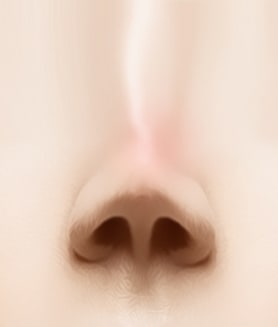
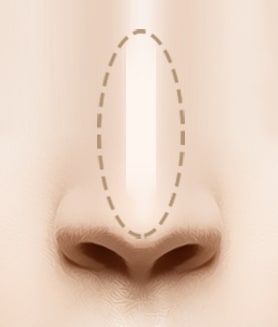
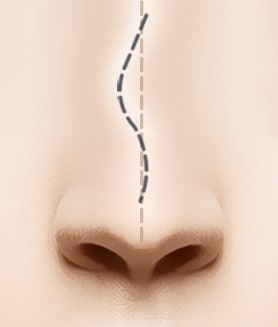
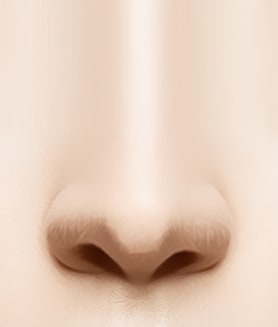
“Why is the revision rhinoplasty rate higher compared to other surgeries? Main reasons are due to side effects of foreign implants such as silicone and simply unsatisfied result. When undergoing a nose surgery, you should consider the long-term result after 10 years and 20 years, not only the short-term result.”
Although many people consider a nose surgery as a simple surgery, the truth is that rhinoplasty is a very complex surgery that requires extensive skills and experiences to give the best results for patients. It is important for a doctor to discover the harmonized ratio for the individual patient as everyone has different features of the face that are suitable for an ideal nose shape.
Because revision rhinoplasty requires a higher level of technique compared to the primary nose surgery, finding an appropriate doctor may be difficult. The doctor should have credentials in nose surgery and performed thousands of revision surgeries. As a university professor, I have continuously practiced aesthetic rhinoplasty, revision rhinoplasty, and reconstructive rhinoplasty such as cleft lip rhinoplasty for over 24 years now. At this moment, I still believe that the revision rhinoplasty is challenging as it requires advanced reconstructive techniques and full focus on the patient as an individual case has different medical records from the previous surgeries.
Most importantly, the doctor who can give you the right advice at the right time is critical for your safety and aesthetic satisfaction. Find the true doctor who can recommend you the most necessary surgeries for you to minimize side effects and maintain your natural beauty. The best time to undergo revision rhinoplasty is after 1 year, but 6 months could be allowed depending on your condition. Not only the reviews and before&after photos are important to choose the clinic, but also a communication with the doctor is essential. Ask the doctor how he/she will perform your surgery, what type of material will be used, and ask about potential side effects as well. Ask about the post-care service the clinic provides as post-care greatly determines the result. Revision rhinoplasty could be a tedious journey but once you find a doctor who you can thoroughly communicate and search a mutual goal together, it is definitely feasible to have a successful result.
Operation Information
- Surgery Time : Varies
- Anesthesia Type : IV Sedation or General Anesthesia
- Hospitalization : 0-1 Day
- Stitch Removal : 7-10 Days
- Recovery Time : 10 Days
13 Side Effects that Immediately Require Revision Rhinoplasty
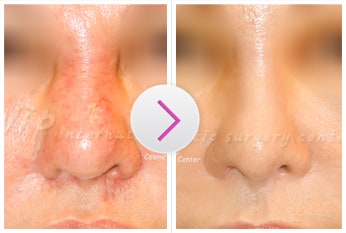
When a foreign implant such as silicone is placed in the nasal tip, the skin gets thinner, so the side effect results. Ear cartilage also could result in side effects when placed in the nasal tip. Therefore, the structural cartilage, which establishes the structure of the nasal tip, could provide a natural result. Such conceptualized premium rhinoplasty is called the autologous tissue rhinoplasty.
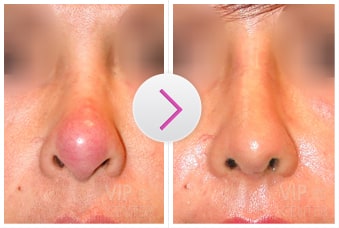
The silicone inserted into the end of the nasal tip irritates the skin resulting in redness and the skin presses the silicone whereby the silicone shows. Therefore, the nasal tip must be constructed by the autologous cartilage, so as to minimize the problems and to appear natural.
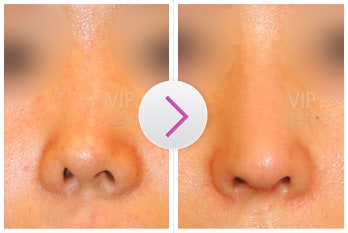
When the inserted silicone is bent inside the nose, it is because the septal cartilage inside the nose was originally deviated and could not support the structure of the nose. If the silicone is inserted without the revision of bent structure, asymmetry will occur based on the bent shape. Therefore, it is important to identify whether a septal deviation exists when planning for nose surgery. If the nasal septum deviates, it is necessary to first revise the bent nasal septum to set up a stable nose structure and then augment the nose. The septal deviation rhinoplasty is highly recommended for these cases.
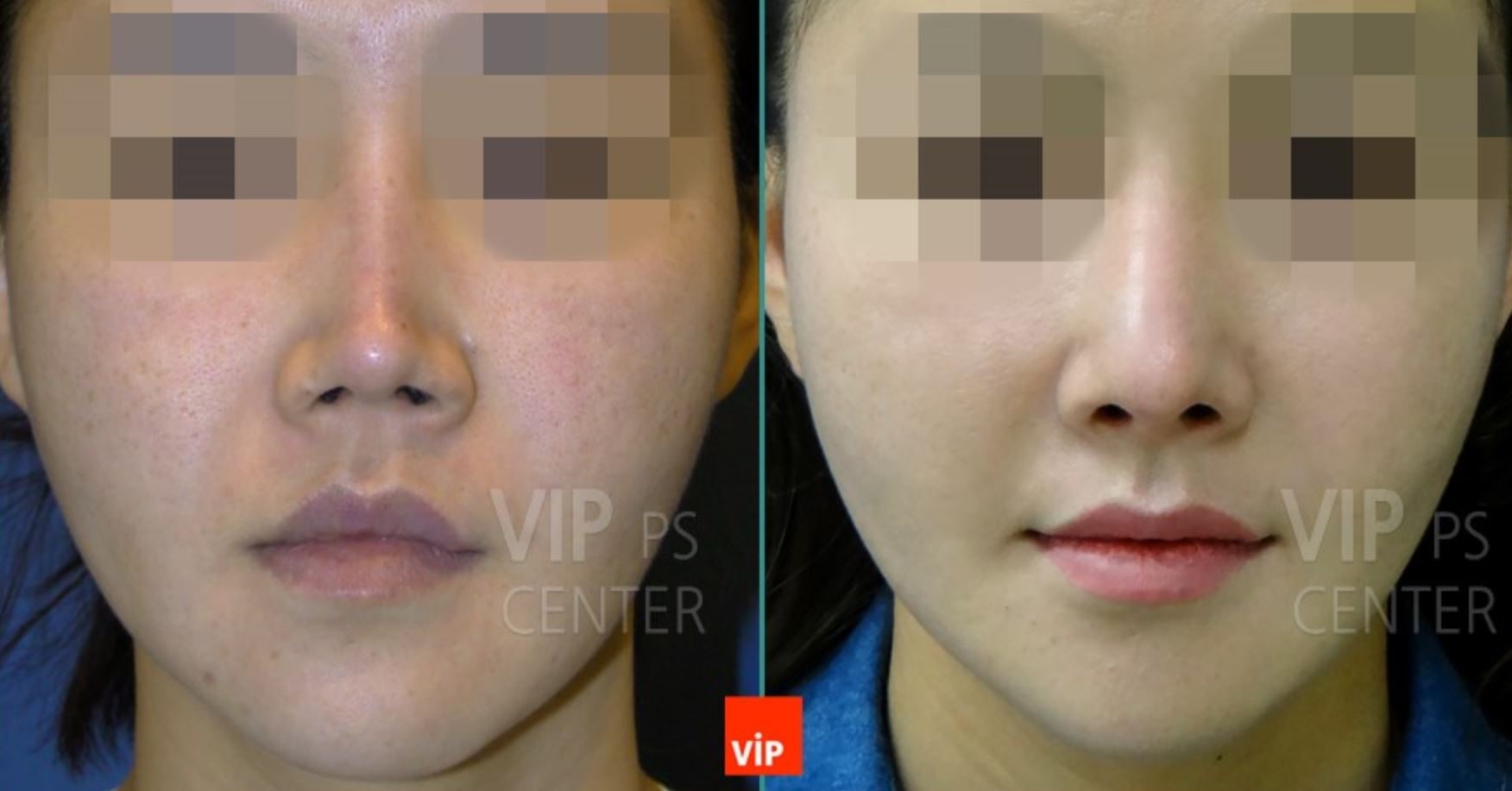
The silicone inserted to the nose tip shows the deformity; the skin gets thinner as time passes by. As the nasal tip is established by the silicone, the skin gets flushed. The newly conceptualized autologous tissue plastic surgery prevents such obvious appearance and creates a natural looking nose.
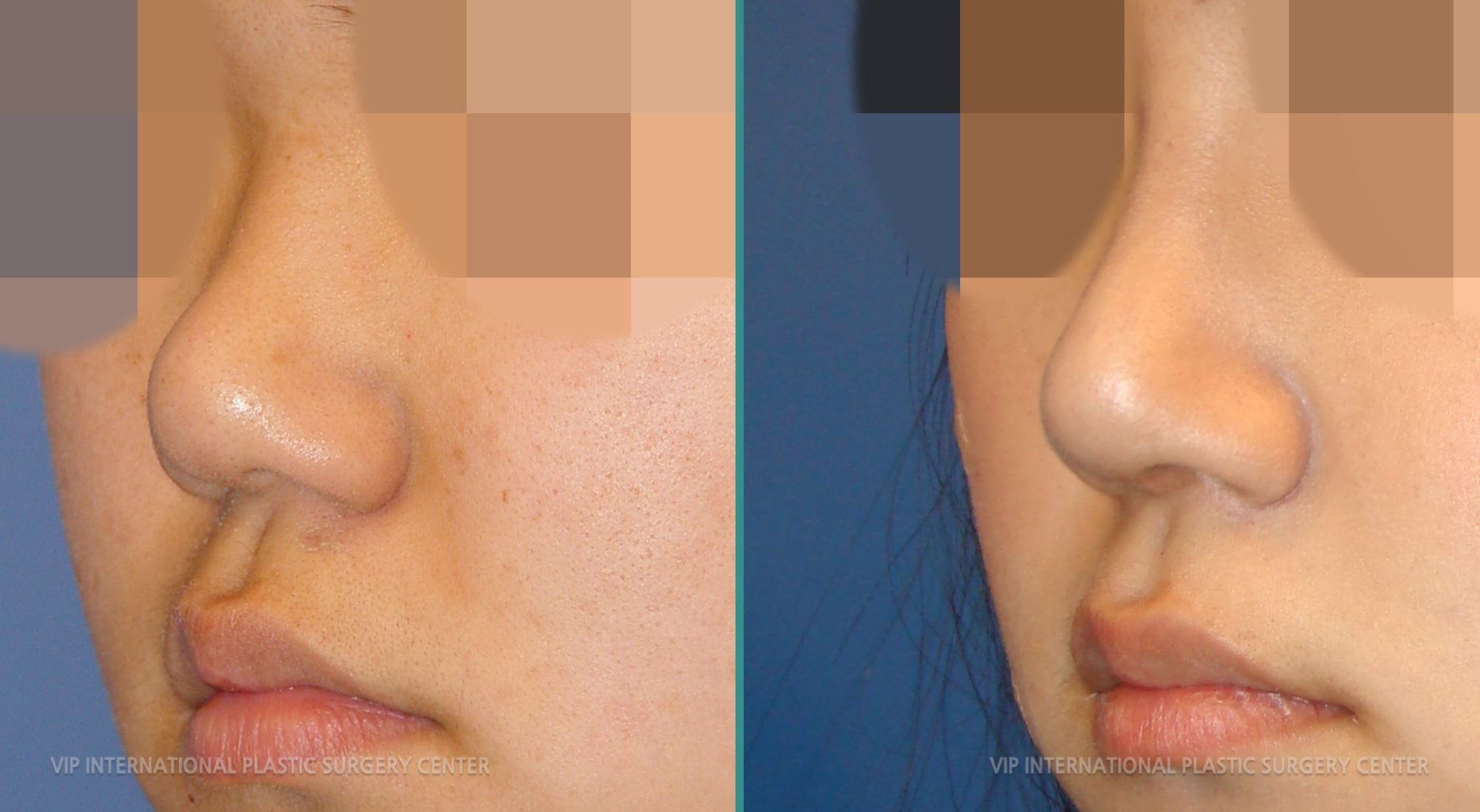
Using the AlloDerm without a structural change of the nose despite its wideness may result in a stubby nose without a two-pointed peak. Therefore, to make a beautiful nose tip, the skin must be thin and the shape of the structural cartilage must be small and protrusive. Thus, a structural nose surgery using autologous tissues is necessary.
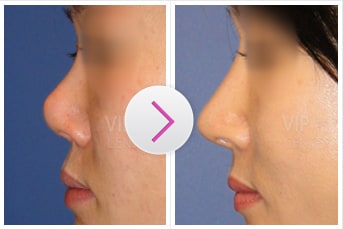
When the contraction occurs due to the implant, the nose becomes severely turned up and the nostrils are more visible. In serious cases, it is necessary to first ensure the length and the structure, and then the height using an autologous tissue.
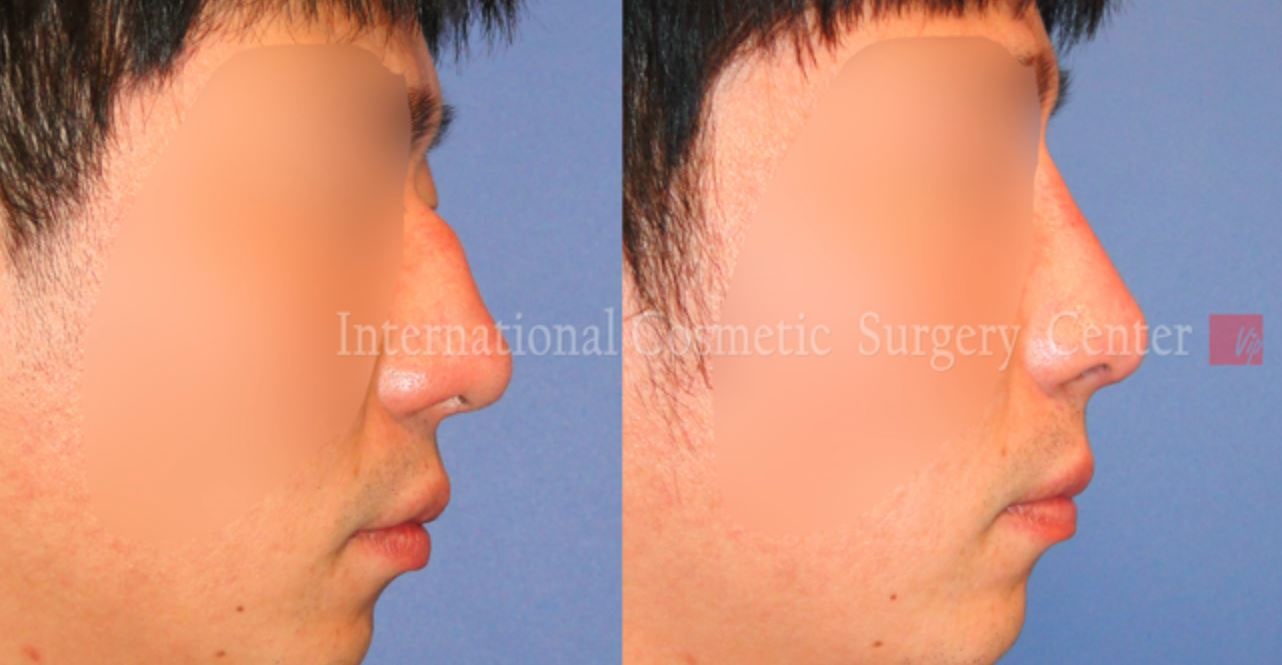
Generally, the droopy nose cannot be improved by inserting silicone on the bridge and the tip, because the cartilage that supports the nose tip is weak and already tilted to the front. It is necessary to support the front of the nose tip with autologous tissue to elevate the droopy tip.
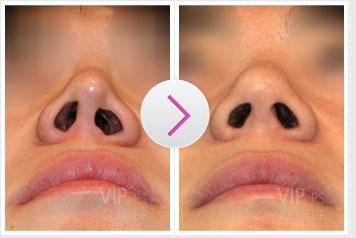
The septal cartilage centered inside the nose plays an important role in making the nostrils symmetrical. In the case of nasal septal deviation or bent septum due to a trauma, it is necessary to improve the nasal septal deviation prior to the nose augmentation procedure.
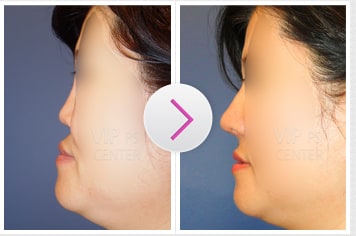
Many Asians have a dented alar base, narrow nasolabial angle, and mouth protrusion. For such people, just augmenting the nose bridge without the improvement of a depressed area and the nasolabial angle makes the nose appear unnatural. Thus, leading to frequent revision surgeries. It is necessary to support a strong structure and then widen the nasolabial angle with VIP’s mid-face augmentation. With these surgeries combined (Harmony Rhinoplasty), the mouth appears to be retruded and the chin looks smaller resulting in a natural and balanced image.
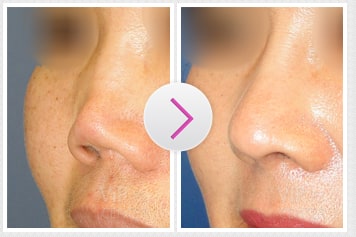
Columella is the part that supports in between the nostrils. If the septal cartilage is short, the columella looks retruded. Therefore, it is necessary to graft the cartilage in between the nasolabial angle to bring out the retruded columella.
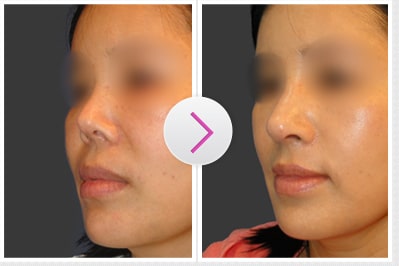
The ideal angle from the columella to the nasal tip is not 90°, but 30°- 45°. This can occur when the silicone or the cartilage is placed forward in a short nose.
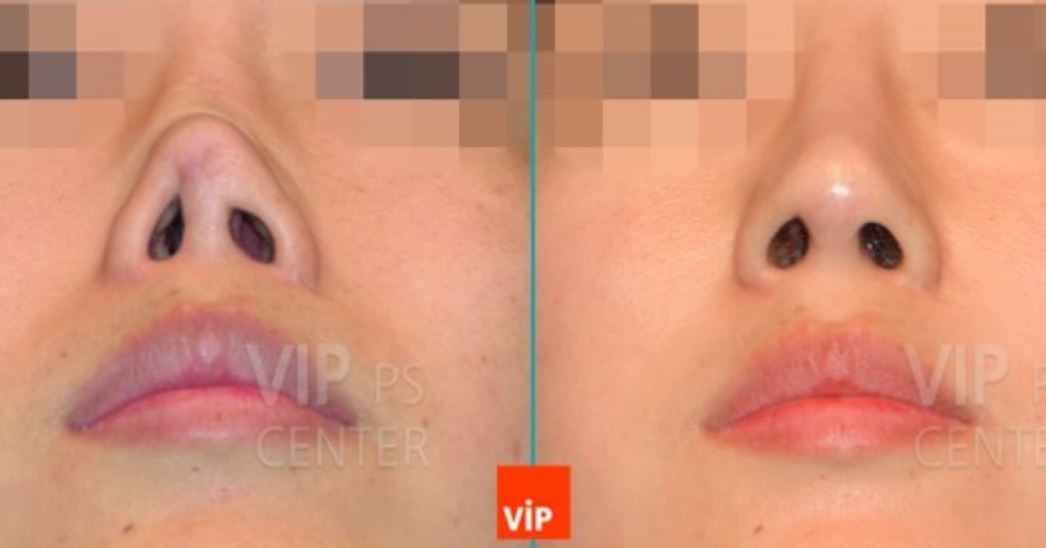
When there is an infection on the implant such as silicone or Gore-Tex, contraction can occur and the nose will deform. The shorter the nose is, the more serious the deformation is. In this case, the autologous tissue is used to rebuild the nose structure.
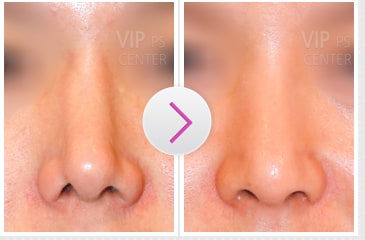
When silicone is injected into the face including the nose, in long term, the skin gets flushed, the tumor grows abnormally, and skin necrosis can occur if serious. Removing illegal injection is the most difficult matter to treat. In this case, the treatment removes the leftover injection and tumor; then uses an autologous tissue to make the structure of the nose with augmentation.
5 Reasons for Increase in Revision Rhinoplasty
Before & After

* Side effects such as inflammation after the surgery may vary by each individuals and may require appropriate treatments. Please check the guideline with the doctor.
Ideal Candidates for Revision Rhinoplasty
Exclusive VIP Revision Rhinoplasty Methods
Revision nose surgery using 100% natural rib cartilage alleviates functional and aesthetic problems such as reddening, infection, deviation, collapsing, sinusitis, and unnatural appearance.
Ideal Candidates for Revision Rhinoplasty
Related Surgeries
FAQ
Contact Us
If you would like to receive VIP doctor’s comments regarding your interested treatment or surgeries, feel free to contact us via mobile messenger app. Please let us know your interested areas with clear photos (front and side) for a free online consultation. Your photos will be privately used for consultation purposes only.
Available via WhatsApp

